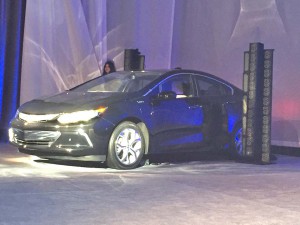
Chevy intentionally made sure reporters got only a brief view of a poorly-lit version of the 2016 Volt during a sneak preview at CES.
A week before its official unveiling at the 2015 North American International Auto Show, Chevrolet pulled off a surprise, giving a small group of reporters a first, brief glimpse of the second-generation Volt plug-in hybrid.
While the unexpected preview at the Consumer Electronics Show revealed a significant shift in styling, Chevy officials withheld specific details, including the range and fuel economy of the 2016 Volt.
But in a subsequent conversation with TheDetroitBureau.com, Chevrolet’s global marketing chief Tim Mahoney did confirm that the updated extended-range electric vehicle will deliver a “significant” increase in mileage, as well as the distance it can travel in all-electric mode, while there will be a number of other improvements, including a roomier and more upscale interior, as well as increased performance.
That should help reverse the recent decline in Chevrolet Volt sales, which were off 30% for the first 11 months of 2014 to less than 1,700 a month. However, “in light of what fuel prices are,” Mahoney cautioned, General Motors’ largest brands has had to set “realistic goals” that may not translate into a major bump upward.
(Tesla extends the range…of it original 2-seat roadster. Click Here for more.)
The first-generation Chevrolet Volt debuted in 2010, becoming the first mass-market automobile to pair an electric motor and a gasoline engine. Under normal conditions, the compact “E-REV” was designed to primarily rely on battery power, traveling an EPA-estimated 35 miles between charges. Under aggressive driving conditions, and when the battery ran down, Volt’s compact gasoline engine would fire up.
That not only improved performance but allowed the Chevy plug-in to keep going, unlike a pure battery-electric vehicle.
(Click Here to learn why conventional, gas-powered vehicles may soon be in the minority, despite cheap gas.)
While Volt received widespread, initial praise, it came to also be criticized for some of its weaker points, including its high price, initially more than $40,000. It was also faulted for a lackluster and cramped interior, with the car’s T-shaped battery pack neatly bisecting the vehicle from front to back.
The 2016 Chevrolet Volt’s design is meant to be more upscale, as well as more aerodynamic. And while there was no chance to inspect the interior during the CES preview, a new battery design reportedly eliminates the big hump in the middle of the passenger compartment.
Meanwhile, marketing czar Mahoney confirmed that Chevy engineers are getting more power out of a smaller pack. According to several reliable sources, the second-gen Volt could nudge up to somewhere closer to 50 miles battery range per charge, while increasing overall fuel economy to well over 100 MPGe from the current 94 miles per gallon-equivalent.
“The packaging is right,” promised Mahoney, adding that “performance is going to be good,” as well.
According to independent reviews, the 2015 version of the plug-in takes about 9 seconds to launch from 0 to 60. That could be cut by a second or more.
(Battery-cars may not be nearly as green as claimed, says new study. Click Here to find out why.)
If Volt could yield 50 or more miles on battery power alone it would potentially expand its appeal to those who might otherwise buy a pure battery-electric model, such as the smaller Chevrolet Spark Electric, Nissan Leaf or Ford Focus EV, as the Chevy Volt would retain the added advantage of being able to fire up its internal combustion engine for longer drives.
Last October, GM did offer a few choice tidbits about the upcoming Volt replacement. CEO Mary Barra revealed the 2016 model will opt for a new 1.5-liter four-cylinder “range-extender” engine. It will be produced in Michigan, along with nearly all the rest of the parts in the next Chevy Volt. The vehicle itself will continue to be assembled on the Detroit-Hamtramck assembly line known to locals as the Poletown plant.
Full details will emerge in a week at the Detroit Auto Show. The 2016 Chevrolet Volt is expected to go on sale by the end of the summer.
